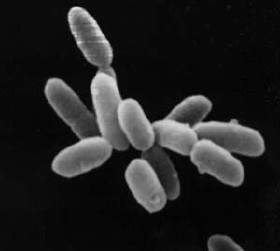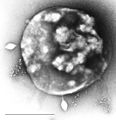Archaea facts for kids
Quick facts for kids Archaea (Archaebacteria) |
|
|---|---|
 |
|
| Halobacterium sp. strain NRC-1, each cell about 5 μm long |
|
| Scientific classification |
|
| Domain: | Archaea Woese, Kandler & Wheelis, 1990 |
| Kingdoms and phyla | |
|
|
| Synonyms | |
|
|
The Archaea (say "Ar-KEE-uh") are a group of tiny, single-celled living things. The name comes from a Greek word meaning "old ones." They are a very important part of life on Earth.
Archaea are simple organisms, much smaller than the cells that make up your body. Scientists first found them in very harsh places, like hot springs or super salty water. These places are called "extreme environments," and the organisms that live there are called extremophiles. But now, we know that archaea live in many normal places too, like in soil and seawater.
Many archaea can live in very hot places (over 80°C or 176°F) or very cold places. They can also survive in water that is very salty, acidic, or alkaline (the opposite of acidic). You can find them in geysers, deep-sea black smokers, and even oil wells. Some archaea in the ocean help by eating ammonia.
For a long time, archaea were grouped with bacteria and called "archaebacteria." But scientists later learned that archaea are very different from bacteria. They have their own unique history and special ways their cells work. Because of this, archaea are now in their own main group of life, called a "domain." In the "three-domain system," the three main groups are Archaea, Bacteria, and Eukaryota (which includes plants, animals, and fungi).
Like bacteria, archaea are prokaryotes. This means they are single-celled organisms that do not have a nucleus or other special parts (called organelles) inside their cells, unlike eukaryotes.
Contents
Archaea: How They Compare to Other Life Forms
Archaea are unique, but they also share some things with bacteria and eukaryotes. Here's a quick look at how they compare:
| Feature | Archaea | Bacteria | Eukaryota (like us!) |
|---|---|---|---|
| Cell membrane | Special fats that are linked differently | Different fats linked in another way | Fats linked like bacteria, but with many different structures |
| Genes | Genes are in a circle. How they read genes is similar to Eukaryota. | Genes are in a circle. How they read genes is unique. | Many straight gene structures. How they read genes is similar to Archaea. |
| Inside the cell | No special parts with membranes, no nucleus. | No special parts with membranes, no nucleus. | Has special parts with membranes and a nucleus. |
| How they get energy | Many ways, including making methane (only archaea do this!). | Many ways, like photosynthesis, breathing with or without oxygen, and fermentation. | Photosynthesis (plants), breathing with oxygen, and fermentation. |
| How they reproduce | Reproduce by themselves (asexually). They can also share genes with others. | Reproduce by themselves (asexually). They can also share genes with others. | Can reproduce by themselves or with another (sexual and asexual). |
Cool Facts About Archaea
- No archaea can do photosynthesis (the way plants make food using sunlight).
- Archaea only reproduce asexually, meaning they make copies of themselves without needing a partner.
- Archaea are good at sharing genes with other archaea. This is called horizontal gene transfer.
- Many archaea love living in extreme environments, like super hot or super salty places.
- Unlike bacteria, archaea do not make spores (tough, resting cells that can survive harsh conditions).
- Archaea are very common in the ocean, especially in the plankton (tiny organisms floating in water). They can make up to 20% of all microbial cells in the ocean!
- A scientist named Carl Woese discovered the Archaea in 1978.
Related pages
Images for kids
-
Archaea were found in volcanic hot springs. Pictured here is Grand Prismatic Spring of Yellowstone National Park.
-
Sulfolobus infected with the DNA virus STSV1. The bar shows 1 micrometer.
-
Archaea that grow in the hot water of the Morning Glory Hot Spring in Yellowstone National Park produce a bright colour.
See also
 In Spanish: Archaea para niños
In Spanish: Archaea para niños








